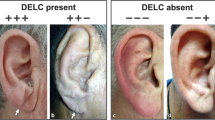Summary
To evaluate whether a significant statistical correlation exists between earlobe crease (EC) and coronary heart disease (CHD), 1000 Japanese adult patients (573 males, 427 females) were examined for the presence or absence of EC, clinical or angiographic evidence of CHD, and the following coronary risk factors: male sex, age over 50 years, obesity, hypertension, diabetes mellitus, cigarette smoking, and hyperlipidemia. Patients were divided into two groups according to clinical evidence of CHD: (1) 237 patients with angina pectoris and/or myocardial infarction (CHD+ group); (2) 720 patients without evidence of CHD (CHD− group). Coronary angiography was performed on 200 patients from this sample population; these patients were also divided into two groups: (1) 119 patients with greater than 50% luminal narrowing of at least one major coronary artery (stenosis+ group); (2) 81 patients with no significant atherosclerotic changes in the coronary arteries (stenosis− group).
EC was present in 58 of 237 CHD+ patients (24.5%) but in only 35 of 720 CHD− patients (4.8%;P<0.001); it was present in 31 of 199 stenosis+ patients (26.1%) but in only 3 of 81 stenosis− patients (3.7%;P<0.01). EC was also found to correlate significantly with some coronary risk factors; the correlations between the presence of EC and the presence of CHD and coronary risk factors were investigated by multivariate analysis. In a multivariate setting, the existence of CHD and an age of over 50 years was significantly related to the presence of EC. To investigate the relationship between EC and advancing age, all patients were separated into age-groups. In each decade of life, the analysis showed a statistically significant association between EC and CHD; it is thus considered that the association of EC with CHD is independent of the patient's age. It is concluded that: (1) the prevalence of EC in Japanese adults is very low compared with the results of previous studies in Europe and America; (2) the prevalence of EC tends to increase with advancing age but is unrelated to other risk factors for CHD; (3) a statistically significant association between EC and CHD is seen from multivariate analysis using both clinical and angiographic criteria in the diagnosis of CHD.
Similar content being viewed by others
References
Frank ST (1973) Aural sign of coronary artery disease (letter). N Engl J Med 289: 327–328
Lichstein E, Chadda KD, Naik D, Gupta PK (1973) Diagonal ear lobe crease: Incidence and significance as a coronary risk factor (abstract). Clin Res 21: 949
Lichstein E, Chadda KD, Naik D, Gupta PK (1974) Diagonal ear-lobe crease: Prevalence and implications as a coronary risk factor. N Engl J Med 290: 1205–1206
Christiansen JS, Mathiesen B, Andersen AR, Calberg H (1985) Diagonal ear-lobe crease in coronary heart disease (letter). N Engl J Med 293: 308–309
Doering C, Ruhsenberger C, Phillips DS (1977) Ear-lobe creases and heart disease. J Am Geriatr Soc 25: 183–185
Kaukola S (1978) The diagonal ear-lobe crease, a physical sign associated with coronary heart disease. Acta Med Scand 619: 1–49
Wyre HW (1979) The diagonal earlobe crease: A cutaneous manifestation of coronary artery disease. Cutis 23: 328–331
Petrakis NL (1980) Diagonal earlobe creases, type A behavior and the death of Emperor Hadrian. West J Med 132: 87–91
Elliot WJ (1983) Ear lobe crease and coronary artery disease: 1,000 Patients and review of the literature. Am J Med 75: 1024–1032
Shoenfeld Y, Mor R, Weinberger A, Avidor I, Pinkhas J (1980) Diagonal ear lobe crease and coronary risk factors. J Am Geriatr Soc 27: 184–187
Sternlieb JJ, Gau GT, Davis GD, Rutherford BD, Frye RL (1974) The ear crease sign in coronary artery disease (abstract). Circulation 50 (Suppl 3): 367
Pasternac A, Sami M (1982) Predictive value of the ear crease sign in coronary artery disease. Can Med Assoc J 126: 645–649
Haft JI, Gonella GR, Kirtane JS, Anastasiades A (1979) Correlation of ear-crease sign with coronary arteriographic findings. Cardiovasc Med 4: 861–867
Shibuya T, Mizuno K, Sugahara H, Arakawa K, Satomura K, Isojima K, Osuzu F, Aosaki N, Kurita A, Hosono K, Yamada (1983) Significance of ear-lobe crease. Shinzo 15: 557–562 (in Japanese)
Lichstein E, Chapman I, Gupta PK, Chadda KD, Smith, Jr H, Schwartz I, Naik D (1976) Diagonal ear-lobe crease and coronary artery sclerosis (letter). Ann Intern Med 85: 337–338
Rhoads GG, Klein K, Yano K, Preston H (1977) The earlobe crease-sign of obesity in middle-aged Japanese men. Hawaii Med J 36: 74–77
Fisher JR, Sievers ML (1980) Ear-lobe crease in American Indians (letter). Ann Intern Med 93: 512
Petrakis NL, Koo L (1980) Earlobe crease (letter). Lancet I: 376
Mehta J, Hamby RI (1974) Diagonal ear-lobe crease as a coronary risk factor (letter). N Engl J Med 291: 260
Scott M (1974) Ear creases, heart disease, and smoking (letter). N Engl J Med 290: 1205
Moncada B, Ruiz JM, Rodriguez E, Leiva JL (1979) Ear-lobe crease (letter). Lancet I: 220–221
Kristensen BO (1980) Ear-lobe crease and vascular complications in essential hypertension (letter). Lancet I: 265
Murai A, Miyahara T, Kameyama M (1983) Ear lobe crease and atherosclerotic vascular disease. Doumyakukoka 11: 579–583 (in Japanese)
Sondel PM (1974) Ear crease, heart disease, and smoking (letter). N Engl J Med 290: 1205
Andersen AR, Christiansen JS, Jensen JK (1976) Diagonal ear-lobe crease and diabetic retinal angiopathy (letter). N Engl J Med 294: 1182–1183
Merlob P, Amir J, Reisner S (1981) Diagonal earlobe crease in newborn infants and in children. Clin Pediatr 20: 739–740
Tsunoda T, Ito I, Katabira Y, Takahashi G (1982) Histological study on the ear-lobe crease. Hihu 24: 352–360 (in Japanese)
Sprague DH (1976) Diagonal ear-lobe crease as an indicator of operative risk. Anesthesia 45: 362–364
Author information
Authors and Affiliations
Rights and permissions
About this article
Cite this article
Toyosaki, N., Tsuchiya, M., Hashimoto, T. et al. Earlobe crease and coronary heart disease in Japanese. Heart Vessels 2, 161–165 (1986). https://doi.org/10.1007/BF02128142
Issue Date:
DOI: https://doi.org/10.1007/BF02128142




